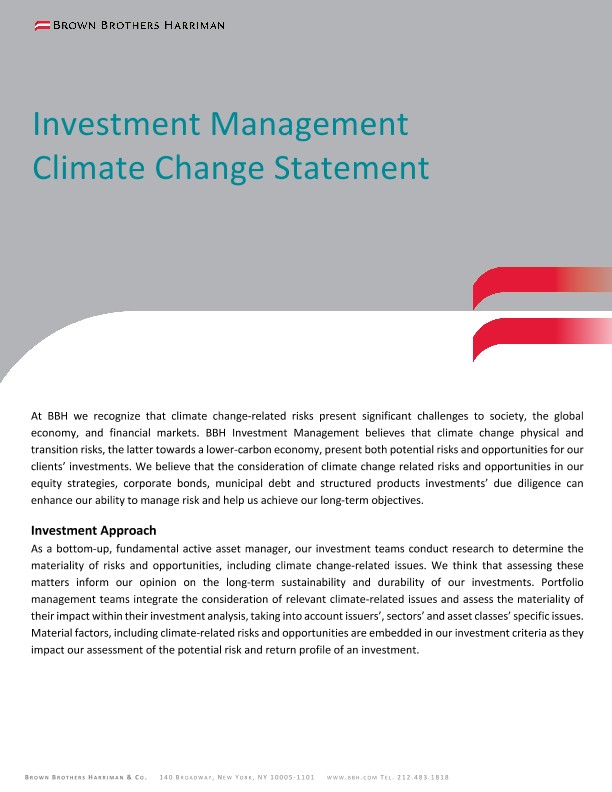At BBH we recognize that climate change-related risks present significant challenges to society, the global economy, and financial markets. BBH Investment Management believes that climate change physical and transition risks, the latter towards a lower-carbon economy, present both potential risks and opportunities for our clients’ investments. We believe that the consideration of climate change related risks and opportunities in our equity strategies, corporate bonds, municipal debt and structured products investments’ due diligence can enhance our ability to manage risk and help us achieve our long-term objectives.
Investment Approach
As a bottom-up, fundamental active asset manager, our investment teams conduct research to determine the materiality of risks and opportunities, including climate change-related issues. We think that assessing these matters inform our opinion on the long-term sustainability and durability of our investments. Portfolio management teams integrate the consideration of relevant climate-related issues and assess the materiality of their impact within their investment analysis, taking into account issuers’, sectors’ and asset classes’ specific issues. Material factors, including climate-related risks and opportunities are embedded in our investment criteria as they impact our assessment of the potential risk and return profile of an investment.
Industry Collaborations
We are a member of the United Nations Global Compact and a our Investment Management team is a signatory to the UN-supported Principles for Responsible Investment (PRI). We support the goals and principles of these organizations, including their efforts to address the challenges associated with climate change.
Governance
On a firmwide basis, the BBH Executive Sustainability Council serves as a governing council for BBH’s sustainability initiatives, overseeing and monitoring our sustainability framework, including the approach to and management of climate change-related risks. In BBH Investment Management, the ESG Oversight Committee (ESG OC) is responsible for monitoring ESG best practices and developments, including those related to climate change. On a regular basis, the ESG OC and our portfolio managers report to the BBH Investment Management Oversight Committee (IMOC), which has ultimate oversight of our investments and of the employment of climate change-related considerations in the investment process.
Fixed Income
For corporate bonds, municipal debt and structured products investments, we assess the physical risks to a given investment, in addition to the risks and opportunities associated with the transition to a lower carbon economy.
When evaluating these risk exposures, we consider the corresponding risk management capabilities on:
- Financial risk – we assess our obligors’ ability to manage the potential financial implications related to climate change risk, as well as their ability to appropriately invest in their businesses towards adopting best practices to support decarbonization of their value chain.
- Operational risk – while we recognize that certain capital-intensive issuers are inherently more exposed to climate change risks, we include them in our investment universe and assess them on the merits of how well they manage these exposure to assess their long-term asset resiliency.
- Capital structure– we test the assumption that the upper tiers of the capital structure, or other secured debt, tend to have lower credit risk in general and to climate change in particular.
- Transparency – to be able to properly evaluate whether climate change risks are recognized, assessed and managed. To this end, we encourage transparency and proactive disclosure of climate change-related data, policies and programs.

